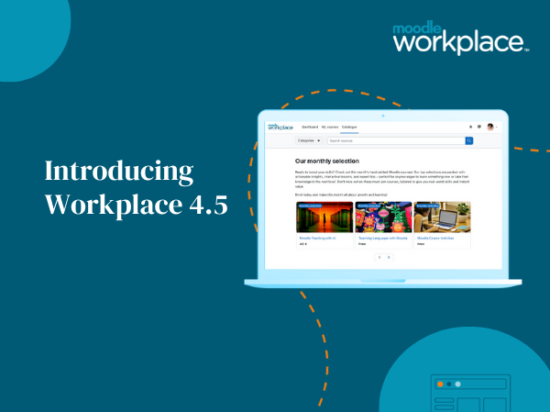Perfect solutions can be harder to find than unicorns; it’s a universal constant that every upside typically has a downside. This certainly applies to education technology too, including the multi-tenant capability available in the Moodle Workplace.
Should your organisation adopt a multi-tenant approach? To fully evaluate LMS multi-tenancy, we need to first understand what it is, and then identify how it may, or may not, help your organisation when applied to a learning management system.
Multi-tenancy explained
Since multi-tenancy is a well-established approach in software architecture, there’s a good chance you have already relied upon it: multi-tenant providers include Google, Amazon, and Salesforce. Putting aside the technical details of multi-tenancy, the central idea is simple: it’s often more effective — in terms of cost, performance, and administration — if multiple entities share one set of resources.
A popular metaphor for explaining multi-tenancy is the modern apartment building. While the building may have many units of different sizes and layouts, they are all collected under one roof and share common areas (e.g., entrance, lobby, stairways, and hallways) and centralised systems (heating, cooling, elevators, etc.). Through this sharing of resources, the building can support a large number of people more efficiently than if each unit was a standalone structure, while still providing tenants the opportunity to create their own unique, independent homes.
Several LMS providers — including Canvas, Blackboard, D2L Brightspace, Cornerstone, and Docebo — utilise multi-tenancy for their clients, and even Moodle sites can be part of a multi-tenant hosting structure. In all these cases, however, the provider is the apartment building and each tenant is an organisation’s LMS. What we’re discussing here is an approach in which your organisation’s LMS site is itself the apartment building, so you can create and manage multiple tenants in the site. Some LMS providers offer this capability, but many do not.
Advantages of LMS multi-tenancy
In a multi-tenant LMS, you can establish a connected ecosystem of multiple learning environments, each a “mini LMS” tenant, without the cost and complexity of maintaining multiple sites. A tenant can have its own branding, users, content, learning sequences, and administration, but tenants are all contained in a single site. The site has one set of resources — hosting infrastructure, database, site management tools — along with options for sharing content, data, and administrative control across tenants.
Another LMS multi-tenant advantage is the ability to create an entirely separate experience for a certain segment of users. With this feature, we actually go beyond what the apartment building of our metaphor can offer. You know when you’re entering a multi-unit apartment building, but with a multi-tenant LMS such as Moodle Workplace, tenant customisation can extend to the moment of user login, and an organisation can ensure that users in one tenant are unaware that other tenants even exist.
Multi-tenancy can help organisations better meet the competing demands that often drive their learning needs by accommodating scenarios for a wide spectrum of stakeholders and initiatives. Here are a few examples:
Internal and external learners
An organization can create one tenant for employee training, perhaps tying access and performance to an HR system; another tenant can serve an external audience, where access might be through a more open mechanism, such as self-registration.
White-label learning spaces
If an organisation delivers training customised for a particular client’s users, a tenant can be configured with branding and curriculum specific to that client, to provide a seamless experience for learners.
Dispersed administration
When the LMS must support several organisations that exercise some level of autonomy — such as businesses belonging to an association, agencies in a municipal government, or owners in a franchise model — each organisation can be assigned its own tenant and assume management of the tenant’s configuration, users, and content.
Distributed content and data
A key advantage of multi-tenancy is the opportunity to distribute curriculum and user management from a single location. In Moodle Workplace, for example, an organisation can share courses, learning paths, reports, and automation rules across tenants.
Disadvantages of LMS multi-tenancy
Despite the have-your-cake-and-eat-it-too benefits of LMS multi-tenancy, this approach does have some potential downsides, which are directly related to the upsides:
Autonomy
How much per-tenant autonomy is not enough, or too much? By design, multi-tenancy balances top-level control with per-tenant administration. For some organisations, potential tenants may want more administrative control than is available; alternatively, an organisation may struggle to delegate per-tenant responsibilities.
Separation
Closely tied to tenant autonomy is the level of separation between tenants. In some cases, an organisation might need more or less sharing of users, content and data between tenants than the system provides; or, tenant separation could simply be too much of an administrative burden, and other less robust forms of user segmentation might be more appropriate.
Centralization
Just as the centralised systems in a multi-unit building limit per-tenant access and options, the single database in a multi-tenant LMS presents similar limitations. Multi-tenancy might be a non-starter if an organisation’s potential tenants require unique databases or access to the shared database. In addition, just as all tenants in an apartment building must accept the design of the building’s exterior and common areas, a multi-tenant LMS typically requires its tenants to agree on various site-level configurations.
Choosing LMS multi-tenancy
Is a multi-tenant LMS right for your organisation? The short answer is probably “that depends,” and a better question might be, “will the trade-offs inherent to multi-tenancy be a good fit for my organisation’s needs?” No matter what you decide, the best way to evaluate multi-tenancy, as with most solutions, is to understand all its downsides and recognise the full potential of its upsides.
This article was originally published on moodle.com







